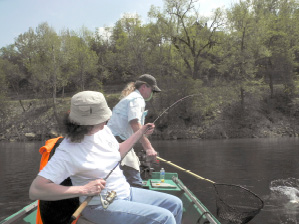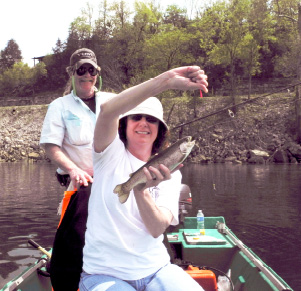
By Kenneth L. Kieser
April 26, 2011
There is no substitution for patience in fishing. Yet, experienced anglers sometimes forget their patience levels while teaching beginners this ancient art that requires tying knots, learning to choose correct baits and actually setting the hook, then landing a fish. Thus, remembering patience is the required trait that all fishing guides find essential with a high percentage of clients.
Richie Hays has made his living as a trout guide working for Gaston’s White River Resort and other docks for 15 years. He has learned how to deal with ever changing conditions on the river from water level fluctuation to weather’s habit of turning a blue bird day into miserable cold, rainy conditions. Problem is, guides like Hays depend on return customers and have to produce fish daily, no matter how bad the conditions or the skill level of each client.
My wife, Cathy, had little experience fishing for trout, not an uncommon situation for many who visit places like the White River in search of their first trout fishing experience. I have fished for trout many years, so Hays situated me in the stern and her beside him in the bow where he could teach her trout angling techniques.
“I was slightly uncomfortable at first, having never met Hays, but soon found his teachings and quiet demeanor gave me the ability to catch several rainbow trout,” Cathy said. “It had been awhile since I fished and welcomed the advice.”
He started by showing her how to cast a spinning rod in a boat where bad casting can result in a hooked co-angler. Later Cathy felt like she was doing something wrong and was comfortable enough to ask him for advice. He broke her cast apart the same way her college baseball coach son breaks a hitter’s swing apart. She understood his instructions and tried again.
“I was pushing with my arm instead of using my wrist,” Cathy said. “Another problem was reeling the line too far up, and the leader knot was inside my guides. He corrected that too and my casts became smoother.”
She soon started laying out casts to productive trout areas. Next, the hard lesson of knowing the difference between a trout biting and fishing weights bouncing off of pea gravel, rocks and logs. This is a lesson best taught by the experience of a real trout bite over trying to explain the difference.
Finally, Cathy learned how to set the hook with only her wrist, an important part of fishing for trout or any other soft-mouthed fish. Setting the hook too hard can easily tear through the thin membrane in a trout’s mouth, especially a brown trout. I sat back fishing and listened to Hays’ advice that was dead-on. But more importantly, he patiently coached her in a quiet, calm voice when she did it right or wrong.
“I always remind myself that beginning trout anglers, young or old, are doing the best they can,” Hays said. “My loss of patience will never help them catch a fish and possibly discourage them from ever fishing again. So I put myself in their place and just work with their strengths and weaknesses.”
Hays demonstrated this by untangling twisted lines around rods and unhooking deeply hooked trout.
Later that morning Cathy hooked a nice rainbow over two pounds. The fish made several desperate runs and jumps before Hays slipped a net under the flopping fish. I realized that she had made the cast, set the hook and successfully caught a trout running against river current on light line—a good trick for any experienced angler.
“I was surprised how pampered Richie made me feel,” Cathy later observed. “The last thing I expected in a fishing boat in the middle of a river was feeling like this. He paid close attention to everything I was doing and made it seem easy. Truthfully, catching a rainbow trout is not that easy and he is a great teacher. I really had fun and those rainbow trout will make a great meal!”
Hays’ own patience levels are occasionally tested by anglers that think they know more than a guide with over 15 years experience of fishing the White River.
“I don’t like being told what to do in my job and just do what they want, until they get tired of not catching trout,” Hays said. “Then, if they let me, I help them. Some days I learn from a client, too. Those are very valuable days.”
About Gaston’s—Gaston’s White River Resort, located by Lakeview, Ark., is unique in featuring excellent food and comfortable accommodations. One evening I had well-prepared steak and lobster, then shrimp stuffed with crab and lobster meat the next night.
Recently I tried their new Field and Stream entrée, a steak with a rainbow trout fillet over the top topped with Béarnaise sauce.
Shoreline lunches are special and very tasty. Trout are prepared over coals in a Dutch oven. Then when the grease is extremely hot, the trout are dropped in with a special breading. Most meals include beans and potatoes with Dutch over cobbler. Lunch guests occasionally land on a grass airstrip by the lodge for lunch.
The lodge has several guides on staff including Hays. Each is experienced and very capable of dealing with the constantly changing conditions. Gaston’s has a conference building that is frequently used by companies for meeting and a get-a-way.
For more information about fishing with Hays, visiting Gaston’s or simply dropping in for a good meal, call (870)-431-5202 or check their web site at: www.gastons.com.

Top: Richie Hays waits to net a rainbow trout for Cathy Kieser. His teachings made this moment possible. Above: Cathy shows off a fine White River rainbow trout while her guide, Richie Hays looks on. Photos by Kenneth L. Kieser















